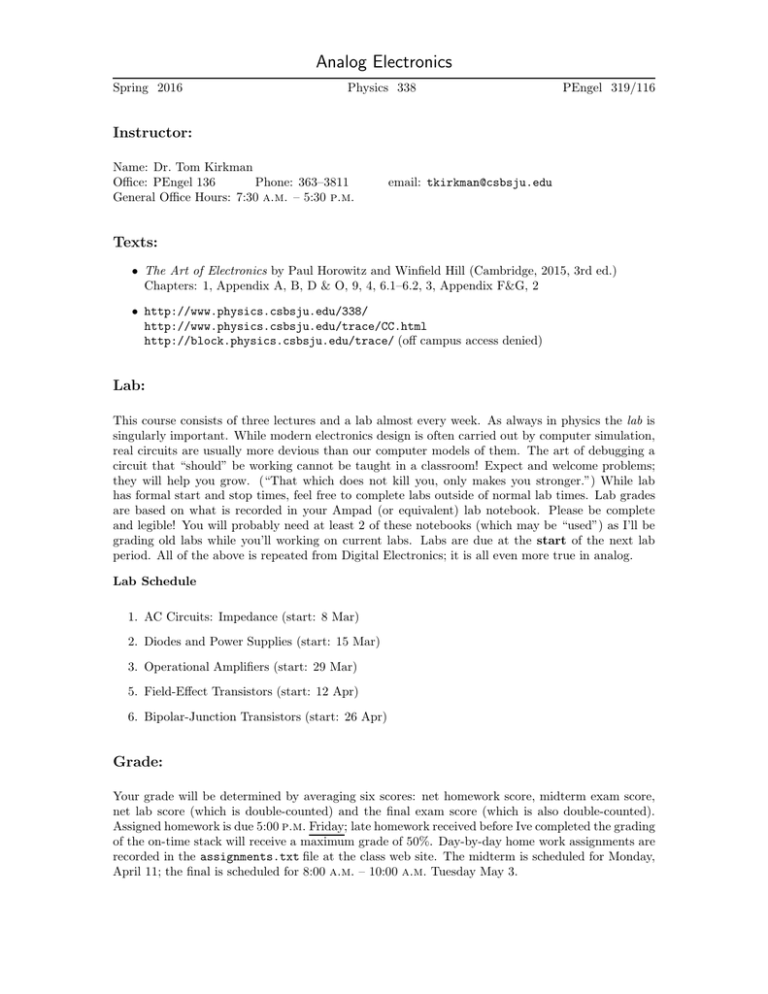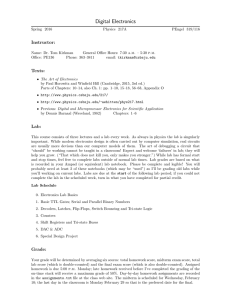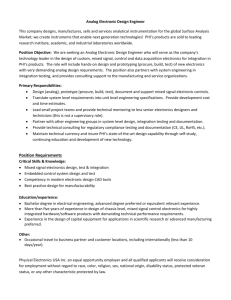Analog Electronics
advertisement

Analog Electronics Spring 2016 Physics 338 PEngel 319/116 Instructor: Name: Dr. Tom Kirkman Office: PEngel 136 Phone: 363–3811 General Office Hours: 7:30 a.m. – 5:30 p.m. email: tkirkman@csbsju.edu Texts: • The Art of Electronics by Paul Horowitz and Winfield Hill (Cambridge, 2015, 3rd ed.) Chapters: 1, Appendix A, B, D & O, 9, 4, 6.1–6.2, 3, Appendix F&G, 2 • http://www.physics.csbsju.edu/338/ http://www.physics.csbsju.edu/trace/CC.html http://block.physics.csbsju.edu/trace/ (off campus access denied) Lab: This course consists of three lectures and a lab almost every week. As always in physics the lab is singularly important. While modern electronics design is often carried out by computer simulation, real circuits are usually more devious than our computer models of them. The art of debugging a circuit that “should” be working cannot be taught in a classroom! Expect and welcome problems; they will help you grow. (“That which does not kill you, only makes you stronger.”) While lab has formal start and stop times, feel free to complete labs outside of normal lab times. Lab grades are based on what is recorded in your Ampad (or equivalent) lab notebook. Please be complete and legible! You will probably need at least 2 of these notebooks (which may be “used”) as I’ll be grading old labs while you’ll working on current labs. Labs are due at the start of the next lab period. All of the above is repeated from Digital Electronics; it is all even more true in analog. Lab Schedule 1. AC Circuits: Impedance (start: 8 Mar) 2. Diodes and Power Supplies (start: 15 Mar) 3. Operational Amplifiers (start: 29 Mar) 5. Field-Effect Transistors (start: 12 Apr) 6. Bipolar-Junction Transistors (start: 26 Apr) Grade: Your grade will be determined by averaging six scores: net homework score, midterm exam score, net lab score (which is double-counted) and the final exam score (which is also double-counted). Assigned homework is due 5:00 p.m. Friday; late homework received before Ive completed the grading of the on-time stack will receive a maximum grade of 50%. Day-by-day home work assignments are recorded in the assignments.txt file at the class web site. The midterm is scheduled for Monday, April 11; the final is scheduled for 8:00 a.m. – 10:00 a.m. Tuesday May 3. Questions: There is no such thing as a dumb question. Questions asked during lecture do not “interrupt” the lecture, rather they indicate your interests or misunderstandings. I’d much rather clear up a misunderstanding or further develop a topic of interest than continue a dull lecture. Remember: you are almost never alone in your interests, your misunderstandings, or your problems. Please help your classmates by asking any question vaguely related to electronics. If you don’t want to ask your question during class, that’s fine too: I can be found almost any time in my office (PEngel 136) or the nearby labs. Topics: This course deals with electronic devices whose outputs and inputs are designed to accept/produce a continuous range of voltages. Consider, for example, a public address system. The microphone detects the varying air pressure which we know as sound and produces an analogous version of the varying air pressure: a varying voltage. (The microphone converts air pressure to voltage and hence is called a transducer .) The electrical power output of the microphone alone is feeble; an amplifier is needed to boost the power while leaving the analogy with the originating sound intact. The amplified voltage is converted back to sound with a reverse transducer: a loudspeaker. If we were to open up the amplifier we would probably find the following components: a power supply which converts the 120 V, 60 Hz a.c. line power to d.c. power, say ±60 V, a single-IC (integrated circuit or chip) which can do a great deal of amplification but is limited to a power output well below 1 watt, and a final stage of amplification in which “discrete devices” like transistors produce the power to drive the loudspeakers. If we were to look up the data sheets for the transistors we would see continuous graphs; the outputs of analog devices are continuous functions of their inputs (indeed often approximately linear functions of inputs). See below. Characteristic Curve for FET 0.0 V .004 A –0.2 V drain V gate Id (A) .003 –0.4 V –0.6 V .002 –0.8 V source V –1.0 V .001 –1.2 V –1.4 V 0 0 2 4 6 Vds (V) 8 10 Network References: http://www.analog.com/ — Analog Devices, Inc. http://www.linear.com/ — Linear Technology Corporation http://www.digikey.com/ — Digi-Key (electronics parts supplier) http://www.newark.com/ — Newark Electronics (larger electronics parts supplier) http://www.pbs.org/transistor/ — the discovery of transistor (history & science)



